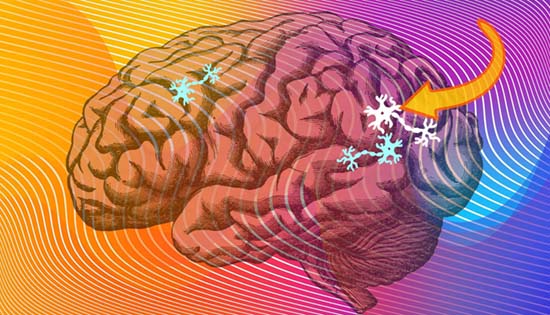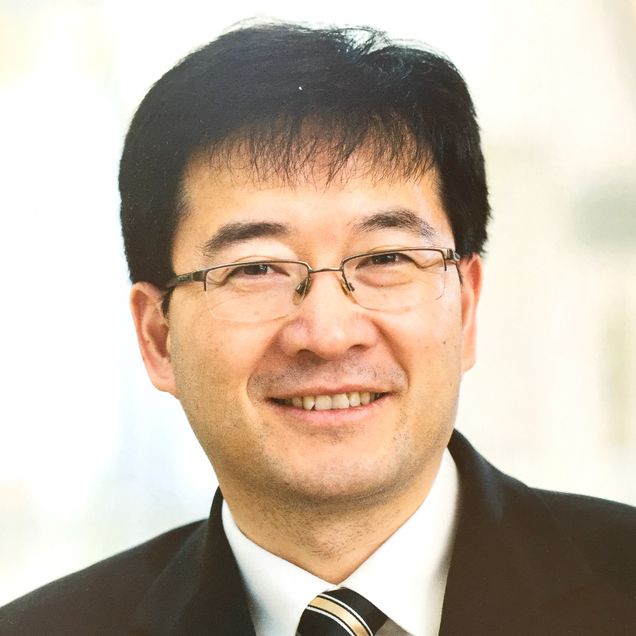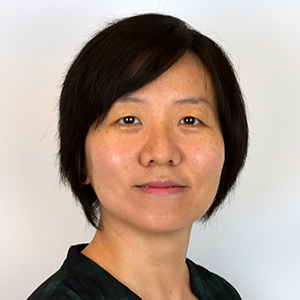Giving Your Neurons a Nudge: ECE Researchers Use Light, Sound and Microwaves to Influence Brain Function

by Allison Kleber
For all the incredible accomplishments of scientific progress, there is perhaps no problem more challenging than the ability to change our own minds. There’s an almost poetic irony to the fact that the seat of the human intellect struggles to penetrate its own inner workings; leaving that perspective to the poets, however, ECE Professors Chen Yang and Ji-Xin Cheng are making measurable inroads into the mystery, although not in the sense of altering subjective opinions. They seek to modify the brain on a more mechanical level, changing the outcomes of various physiological processes it controls. These investigations promise to provide not only new insights into brain function as a whole, but also more direct clinical applications.
Neuromodulation, which is the process of altering nerve activity through targeted delivery of a stimulus or inhibiting factor directly to a specific part of the brain, is far from a novel concept in and of itself. Current applications show therapeutic promise in the treatment of a wide variety of ailments, from epilepsy and Alzheimer’s to vision loss. However, as with most processes that interact directly with the delicate and complex structure of the body’s most essential organ, there is considerable room for improvement.
Professors Cheng and Yang are investigating the use of two novel methods, optoacoustics and microwaves, to approach neuromodulation from opposite angles: neural stimulation, and neural inhibition.
Optoacoustic Stimulation
The activation and excitation of neural circuits for clinical purposes is currently achieved using a variety of methodologies, each with their benefits and drawbacks. Electrode-based deep brain stimulation (DBS), for example, is used to treat epilepsy, Alzheimer’s, and Parkinson’s disease, but it is both highly invasive (electrodes must be implanted deep in the tissue of the brain) and not very precise, while optogenetic actuation, which involves genetically altering neurons to react to light stimulation, has shown promise for vision restoration, but uses a viral vector to make its changes, which carries complex ethical considerations when used in human subjects.
Focused ultrasound has shown some promise as a method of neural stimulation, as it is noninvasive, yet offers significant penetration depth; however, it also falls short when it comes to precision. However, optoacoustics–a method which converts pulses of light to acoustic waves at ultrasonic frequencies, already widely adopted for biological imaging–bypasses this limitation, combining the high penetration depth of ultrasound with the high spatial precision available from photonics.
Funded by grants from the National Institute of Health (NIH) Brain Initiative, Professor Ji-Xin Cheng, Professor Chen Yang, and co-PI Professor Xue Han of the the department of Biomedical Engineering are at the helm of an ongoing project to explore and develop optoacoustic neuromodulation. First reported in Nature Communications in 2021, a feature article published in Neurophotonics in late March charts their progress.
There is considerable excitement over this emerging technology; as Professor Cheng notes, “we are [being] approached by companies and investors worldwide” who are interested in its potential applications. Yet, as SPIE News notes, optoacoustic neuromodulation is at the very earliest stages of exploration, and there are many unanswered questions. First and foremost: optoacoustic neuromodulation works … but researchers are not yet certain why. Clearly, continued investigation is called for. At the same time, Cheng’s group has ambitious plans to refine and develop a wide variety of applications and delivery methods for their newly-minted methodology.
One thing is for certain: when it comes to optoacoustics, it’s not just lab-mediated neurons that are getting excited.
Microwave Inhibition
Useful as it can be to get those neural circuits all worked up, there’s something to be said for the opposite, as Professor Chen Yang can tell you. Another form of modulation, neural inhibition, can be highly effective at suppressing adverse and maladaptive neural activity, and with support from a $75K Ignition Award from BU’s Office of Technology Development, she’s sure she’s found a superior method for deploying this process.
Like optoacoustics, microwaves have a high penetration depth into the human brain, and the capacity for high precision as well. As early as the 1970s, the application of low-intensity microwaves for more than a minute were shown to significantly reduce the firing of specific neurons; however, the cellular and molecular mechanism of this effect has remained unknown and unexplored, and its potential untapped, until now.
According to Professor Yang, the inhibiting effect of microwaves on neural activity holds great promise for non-invasive, non-pharmaceutical pain management, particularly in the case of chronic neuropathic pain, which originates from damage or disease affecting the somatosensory system; the part of the sensory nervous system associated with touch, temperature, etc. It’s a condition commonly related to diabetes, shingles, HIV, sciatica, cancer, and postoperative side effects, and has proven frustratingly resistant to pain medication and most other therapies.
Professor Yang, alongside co-Investigators Professor Cheng and Research Scientist Lu Lan, propose to develop a small, minimally invasive device that uses microwave neuroinhibition to manage neuropathic pain far more effectively, and safely, than any currently-available method. This wirelessly-powered device, measuring just a few milimeter, could be implanted via a simple outpatient procedure, possibly even an injection. Situated directly over a targeted nerve bundle, where it would act “like an on-demand, repeatable injection of lidocaine,” providing significant–perhaps even total–relief.
Yang’s team plans to begin designing and fabricating prototypical versions of this device in the near future, and several consultants among the medical establishment have already expressed interest in future collaboration, should the device eventually proceed to clinical trials.
In the meantime, Professor Yang and collaborators, Professor Cheng and Professor Qiang Cui of the Chemistry department, are pursuing a complementary investigation into the cellular and molecular mechanism of microwave neuromodulation, backed by a $650K grant from the U.S. Army Combat Capabilities Development Command’s Army Research Laboratory. Starting with a new hypothesis for this mechanism, related to the rotational frequency of water, they will seek validation and additional insights using a variety of tests, both experimental and computational.
 Professor Ji-Xin Cheng is the BU Department of Electrical and Computer Engineering’s inaugural Theodore Moustakas Chair Professor in Photonics and Optoelectronics. His ground-breaking work in medical imaging and myriad other optical technologies and applications has earned him significant honors.
Professor Ji-Xin Cheng is the BU Department of Electrical and Computer Engineering’s inaugural Theodore Moustakas Chair Professor in Photonics and Optoelectronics. His ground-breaking work in medical imaging and myriad other optical technologies and applications has earned him significant honors.
Professor Chen Yang received her PhD from Harvard University in 2006, and currently holds a dual appointment to Boston University’s Departments of Electrical and Computer Engineering and Chemistry. Her research interests include nanomaterial-based photonics and electronics for neuromodulation and live cell sensing.